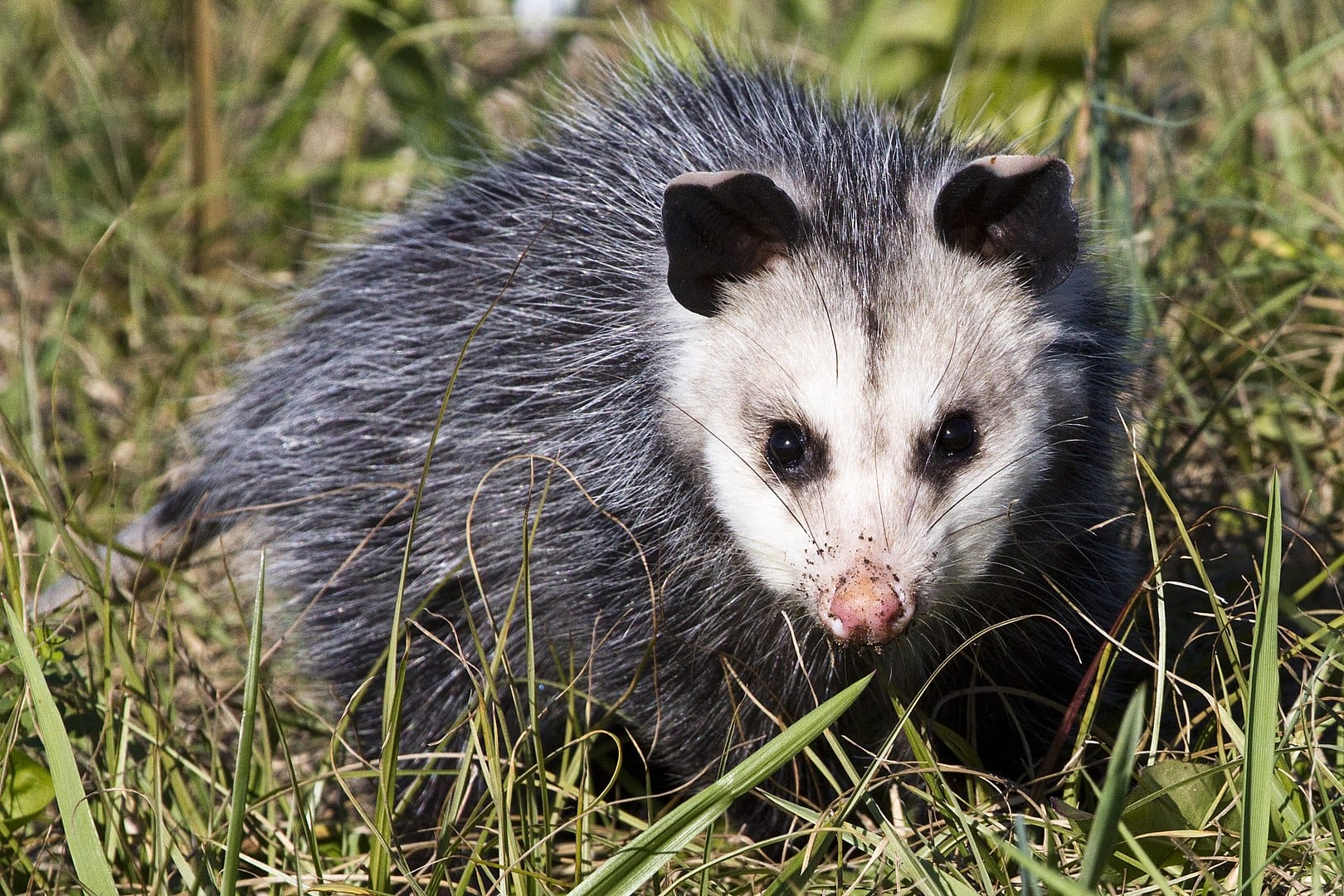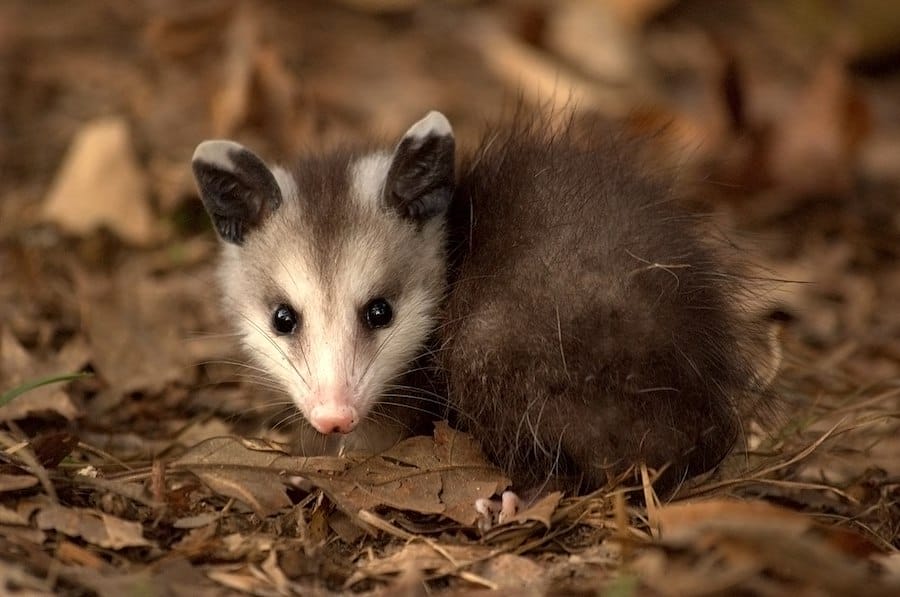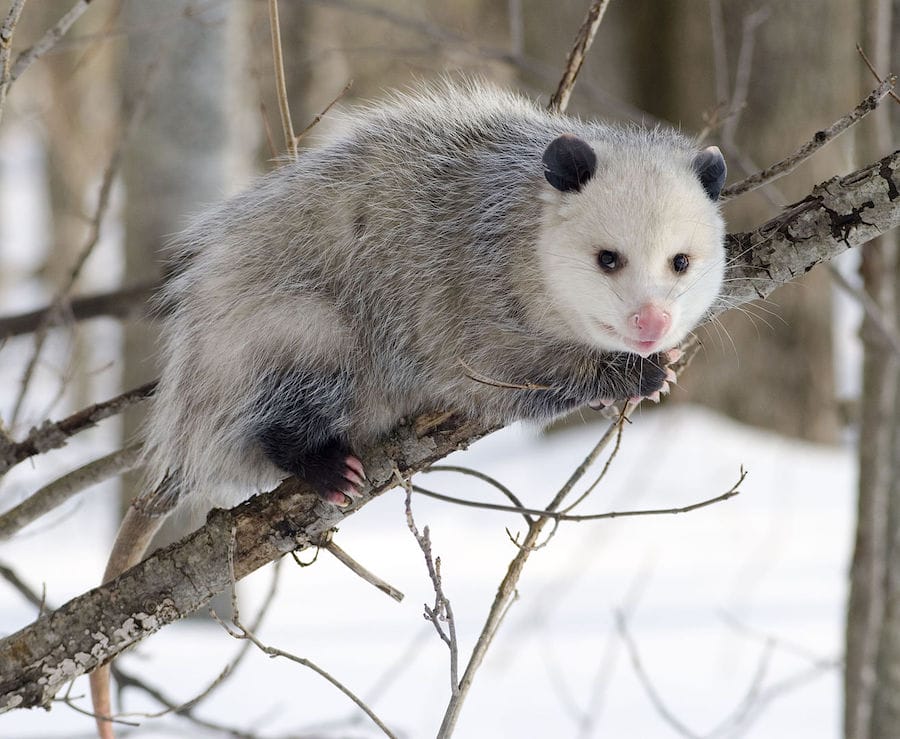

Uh oh...
It appears that you're using a severely outdated version of Safari on Windows. Many features won't work correctly, and functionality can't be guaranteed. Please try viewing this website in Edge, Mozilla, Chrome, or another modern browser. Sorry for any inconvenience this may have caused!
Read More about this safari issue.

The feathers scattered on the ground by the chicken coop door were the first sign of the attack. The second: except for the long-gone chicken breast, the bird’s carcass lay untouched. Evidence clearly pointed to an opossum as the culprit, one of many frustrations that contributes to the hate-filled relationship with possums in Arkansas.
Commonly referred to as “possums,” opossums are found throughout Arkansas and generally evoke a negative response from humans. Their large teeth and rat-like tail can be off-putting, but these unique creatures aren’t all bad. The source of the phrase, “playing possum” because they pretend to be dead when faced with danger, opossums actually bring a few benefits to regions where they live.

Possum or Opossum: Either Name Will Do
The word “possum” appears to be a colloquialism most commonly used in the South and was first documented in 1613. Most people use the word when referring to the species known as the Virginia opossum (Didelphis virginiana), although an actual possum is a different species only found in Australia. The Virginia opossum is the only species of opossum in North America. Its name is derived from the Algonquin word “wapathemwa,” which means “white animal.” Capt. John Smith of Jamestown Colony in Virginia first referred to the animal as an opossum in 1608. Although some sources explain the mispronunciation by saying that the “o” in opossum is simply a silent letter, dictionaries and the pronunciation guides for opossum indicate that the “o” should be pronounced.

Jacks, Jills and Joeys: A Marsupial Family Member
Opossums are Arkansas’s only marsupials, a type of animal generally characterized by giving birth to young that are not fully developed. Male opossums are “jacks,” females are “jills,” and their young are called “joeys.” While opossums typically have eight or nine newborns at a time, they can give birth to as many as 20, all of which you could fit in a teaspoon. Many marsupials have a pouch that will help hold the young in place until they reach proper development. The female Virginia opossum has an underdeveloped pouch, so their young will latch on with their mouths and front paws, where they will remain for as long as two months. When they get too big for the pouch, you might spot them riding around on their mother’s back.

Rat Tails and Big Teeth
One of the opossum’s most defining characteristics is its long hairless tail. Even though the proverbial picture of opossums shows a family hanging from a tree branch, you see this behavior mostly exhibited by juvenile members. Possums use their tail much like a fifth limb for balance, climbing and even for carrying items such as leaves or sticks. Male possums will use their tail to generate a scent to mark their territory and to signal other opossums to danger silently. Signaling humans isn’t so silent. Faced with an opossum in your path, you will likely be met with a loud hissing and a mouthful of sharp teeth. Possums have 50, the most of any mammal, so it’s not surprising that when threatened, they show them off. Interestingly, possums aren’t smart enough to realize that biting could be a beneficial defense mechanism.

Should They Stay or Should They Go
Opossums are considered a nuisance animal. According to the Arkansas Game and Fish Commission, opossums that are causing damage to personal property may be taken during daylight hours or trapped the entire year: no hunting permit or license needed. So when you walk into your chicken coop to find your flock damaged by a hungry opossum, you can eliminate it without remorse. But opossums are not all bad. If your flock isn’t threatened, you may want to let the opossums stick around.
- They eat garden pests. Opossums love to dine on snails, slugs and other garden pests. They may eat low hanging fruit or fruit that has fallen to the ground, but that problem can be easily remedied with chicken wire, garden plastic, or other methods commonly used to protect gardens from wildlife.
- They can be handy street cleaners. Possums like roadkill. The easy meal satisfies their belly and also helps to keep the road clean. (Sadly, it also means they might become roadkill themselves.)
- They are immune to rabies. Due to a lower body temperature than most mammals, they cannot contract rabies, nor can they spread the disease.
- They kill poisonous snakes. In general, opossums are not affected by the venom of snakes. So while it may be illegal for you to kill a snake in Arkansas, the opossum can do the job for you with little to no risk of injury.
- They are natural tick vacuums. According to the Arkansas Department of Health, ticks are responsible for transmitting more diseases than any other insect. Thankfully, possums are excellent groomers and regularly dine on ticks found in their fur and on their bodies. A single opossum can consume more than 5000 ticks annually.

Food for Thought
The opossum is also known as a food source for humans. Most Arkansans know someone who brags about the opossum stew their grandmother made back in the day, but few would be willing to dine on one today. Is it possible to eat an opossum? Yes. Should you? If you really want to show that thieving possum who stole your eggs and ate your chickens who’s boss you could fry one up for your next family gathering. Or, simply stick with something a little tastier like Arkansas Possum Pie, no actual opossum required.
We do the work.
You check your email.
Sign up for our weekly e-news.
Get stories sent straight to your inbox!











 Leave a Reply
Leave a Reply
Interesting article. I especially enjoyed reading the reasons for letting them “stay.”
Thank you for this!! I have Alpha-gal Syndrome, and actively advocate the benefits of protecting opossums. Those of us living with tick-borne illnesses know that they are the best natural defense that we have.
Thank you for this! I have Alpha-gal Syndrome, and actively advocate for the protection of opossums. Those of us with tick borne illnesses know that they are the best natural defense that we have.
I never knew the fact Opossums cannot contract Rabies or spread them, nor did I know they eat ticks or snakes like that. Very interesting!
Enjoyed the article on the opossum. Thanks. It should be required reading for all those who do not like the animal. I learned about their tick consumption last year and have considered them a friend since.
[…] Check out our articles about Bobcats, river otters and opossums. […]
[…] spotted animals along Arkansas trails include lizards and salamanders, armadillos, squirrels, possums, and […]
[…] Opossums are known for their adaptability, which extends to their winter habits. While many animals are hidden away during the colder nights, opossums emerge to explore the winter landscape. Their foraging activity increases during winter as they search for food in the quieter nighttime hours. […]